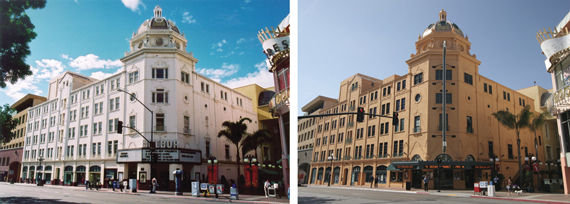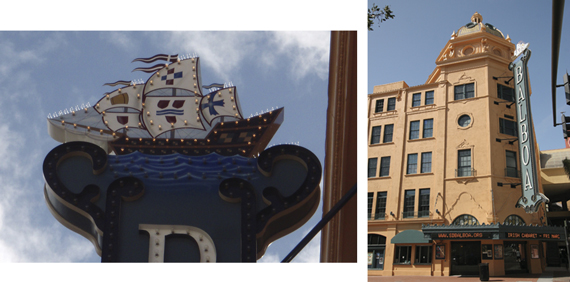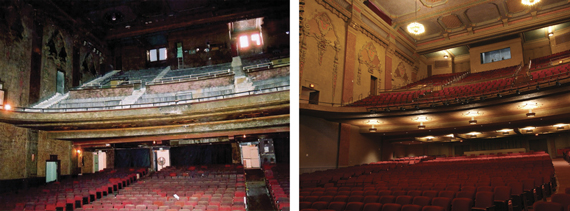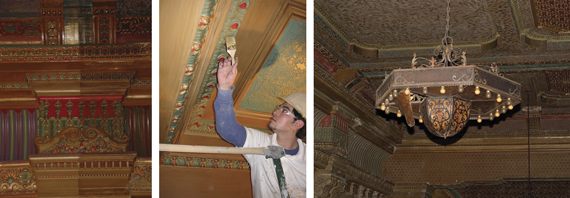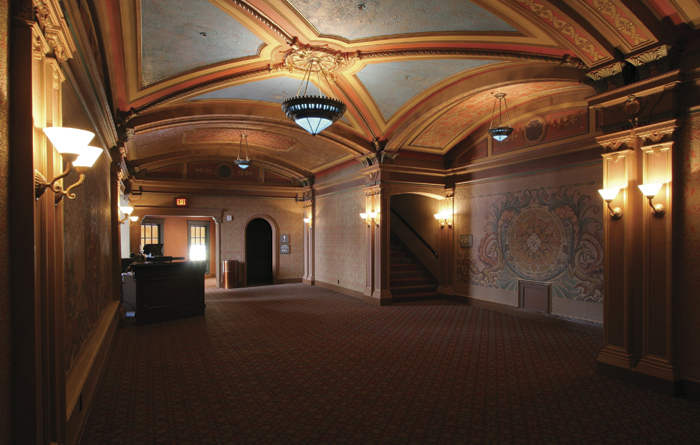 |
Balboa TheatreAnatomy of a RestorationBy David Marshall, AIA After 22 years of failed proposals by well-meaning but under-funded private interests, the Balboa Theatre at Fourth Avenue and E Street in downtown San Diego has finally been restored. The Centre City Development Corporation (CCDC) came to the rescue of this historic landmark, digging into their own coffers of tax increment funds, they contributed over $26 million to make the project a reality. Work on the 1924 icon included not only the restoration of finishes, but seismic strengthening, disabled access compliance, and all new utilities.
Left The Balboa Theatre in 2002 before restoration began. Note the non-historic white paint and red tile base. The original blade sign and ornate marquee had been removed in prior years. The mundane replacement marquee had plastic letters and covered up three historic art glass windows. Right After 22 years of failed proposals by well-meaning but under-funded private interests, the Balboa Theatre at Fourth Avenue and E Street in downtown San Diego has finally been restored. The Centre City Development Corporation (CCDC) came to the rescue of this historic landmark, digging into their own coffers of tax increment funds, they contributed over $26 million to make the project a reality. Work on the 1924 icon included not only the restoration of finishes, but seismic strengthening, disabled access compliance, and all new utilities.
Left Balboa's ship appears at the top of the blade sign. A lot of guesswork was necessary to detail the ship since the historic photographs didn't have clear views of it. Just weeks before the completed ship was going to be hoisted into place, additional historic photos were found and the ship was sent back to the fabricator and repainted to be more accurate. Right View of the main entrance and tile-domed tower showing the reconstructed blade sign. When private developers were planning to restore the theater in years past they were considering selling the naming rights of the Balboa Theatre. Such an arrangement could have resulted in the BALBOA blade sign reading RUBIOS or JENNY CRAIG instead. The original marquee was missing since the 1930s and no drawings existed of its design. However, several historic photographs from the late 1920s showed the marquee in enough detail that building a replica was possible. The marquee canopy and blade sign cost $216,000 to recreate.
Left A flat 1950's ceiling was removed from the entry rotunda, revealing that much of the plaster ornamentation was missing or damaged, the upper floor windows were gone, and there were gaping holes in the walls and vaulted ceiling. The pink and green colors were also not historic. Middle The completed rotunda with its ornamentation, windows, and lighting restored. The historic colors were identified through scraping tests and reapplied. Right This view of the restored entry rotunda shows the restored glass entry doors (left) and the new exterior doors (right). The new doors were added to enlarge the tiny lobby and to protect the etched glass and historic mosaic tile floor which depicts Vasco Núñez de Balboa's sailing ship and "1513," the year he reached the Pacific Ocean.
Left The interior of the theater in 2000, prior to restoration. Note the patchwork of non-historic seats and the heavily tarnished walls. The CCDC deserves much credit for keeping the building watertight and free from vagrants during its 20-year hibernation. Right The same view showing the restored audience chamber in 2008. 1,300 new seats, restored lighting, and over $800,000 worth of decorative painting combine to create a dramatic upgrade. It should be noted that the theater was originally built for $800,000 in 1924.
Left The right half of this photograph shows the original paint on the auditorium wall after the historic bronze powder paint had tarnished to a dark brown. The left half shows the "jewel box" look of the newly applied finishes as part of a paint restoration test. The entire theater was eventually restored using a non-tarnishing bronze powder paint to recreate the gilded historic appearance. Middle Bronze powder being dry-brushed on the auditorium ceiling. Many thousands of hours of decorative painting by New York's Evergreene Studios were required during the restoration. Right This "before" view shows one of the surviving chandeliers in the main audience chamber. All of the historic light fixtures were completely restored and rewired by Gibson & Gibson Antique Lighting. Also note the stained and tarnished decorative paint work in the background.
Left An artist uses a stencil above the proscenium to recreate the 1924 tapestry pattern. Decorative painting of the upper walls and ceiling required an extensive scaffolding system that cost $100,000. The wood platform they stood (and sat) on high above the theater was nicknamed the "dance floor." Middle Areas of damaged and missing plaster ornamentation required repair and replication. The white portions in this photograph are the recreated pieces of the Salon's ornamental plaster prior to painting. Right Perhaps the most dramatic transformation at the Balboa Theatre was the second floor "Salon" lobby. This 2000 photograph shows the non-historic paint colors, flooring, and light fixtures prior to restoration.
The Salon as it appears today after restoration and decorative painting. The murals and stencils were recreated from a single 1924 photograph and paint scrapings were studied to establish the color palette. David Marshall, AIA, is a former member of the city's Historical Resources Board, a past president of SOHO, and author of "San Diego's Balboa Park." All photographs were taken by the author, Alex Eberle, and Curtis Drake, of Heritage Architecture & Planning. |
2008 - Volume 39, Issue 1/2MORE FROM THIS ISSUE Survivors of San Diego's Theatrical Past Professional Theater Comes to San Diego Preservation Community
Reflections
DOWNLOAD full magazine as pdf (16mb) |
Mailing - PO Box 80788 · San Diego CA 92138 | Offices - 3525 Seventh Avenue · San Diego CA 92103
|
